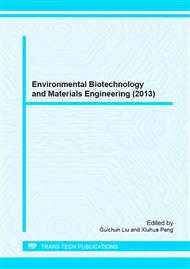p.112
p.117
p.122
p.127
p.133
p.139
p.143
p.151
p.161
Research on Methods of Treatment of S-Triazine Wastewater by UAOPs Enhanced METs
Abstract:
The paper is researched the main applications of micro-electrolysis enhanced by united advanced oxidation processes (UAOPs): O3/UV/Fe (OUF) and micro-wave/Fenton (MWF). Better removal efficiency was found in O3/UV/Fe3+ (OUFIII) METs than O3/UV/Fe2+ (OUFII) METs in the same pH conditions. In acid condition, the best degradation rate 44.7% could be achieved in the whole study. However, a 37.3% decrease in TOC was observed in basic condition. An inflexion point was observed at 2 hour at different dosages of H2O2 by MWF METs, which were probably caused by the branched chains cleavage from the s-triazine ring. With H2O2 dosage of 10% and a hydraulic retention time (HRT) equals to 5 hours, a best deduction of 26.5% was observed. Nevertheless, it is suggested OUFIII technology was found to be the optimum enhanced METs for the treatment of s-triazine wastewater.
Info:
Periodical:
Pages:
133-136
Citation:
Online since:
September 2013
Authors:
Price:
Сopyright:
© 2013 Trans Tech Publications Ltd. All Rights Reserved
Share:
Citation:


